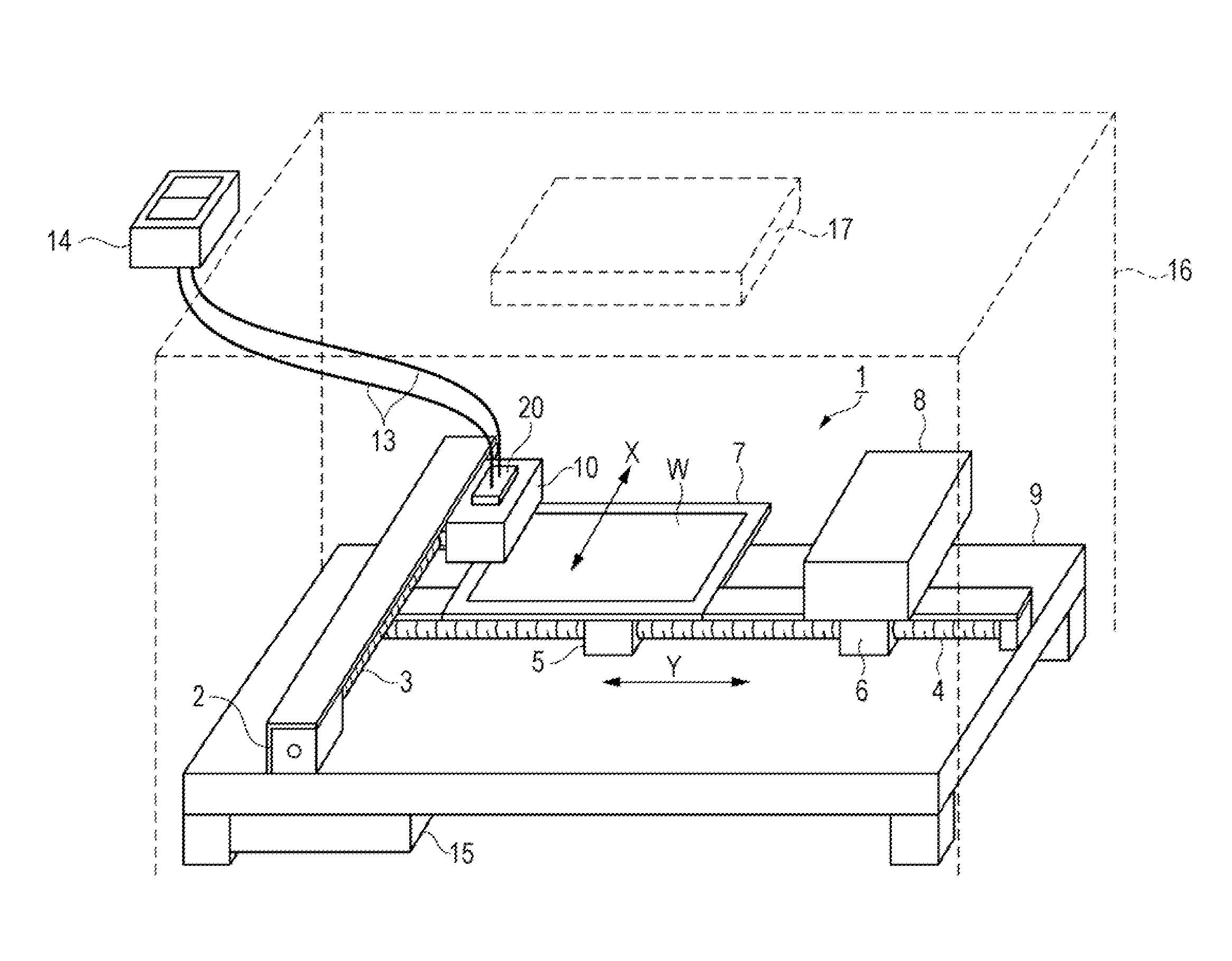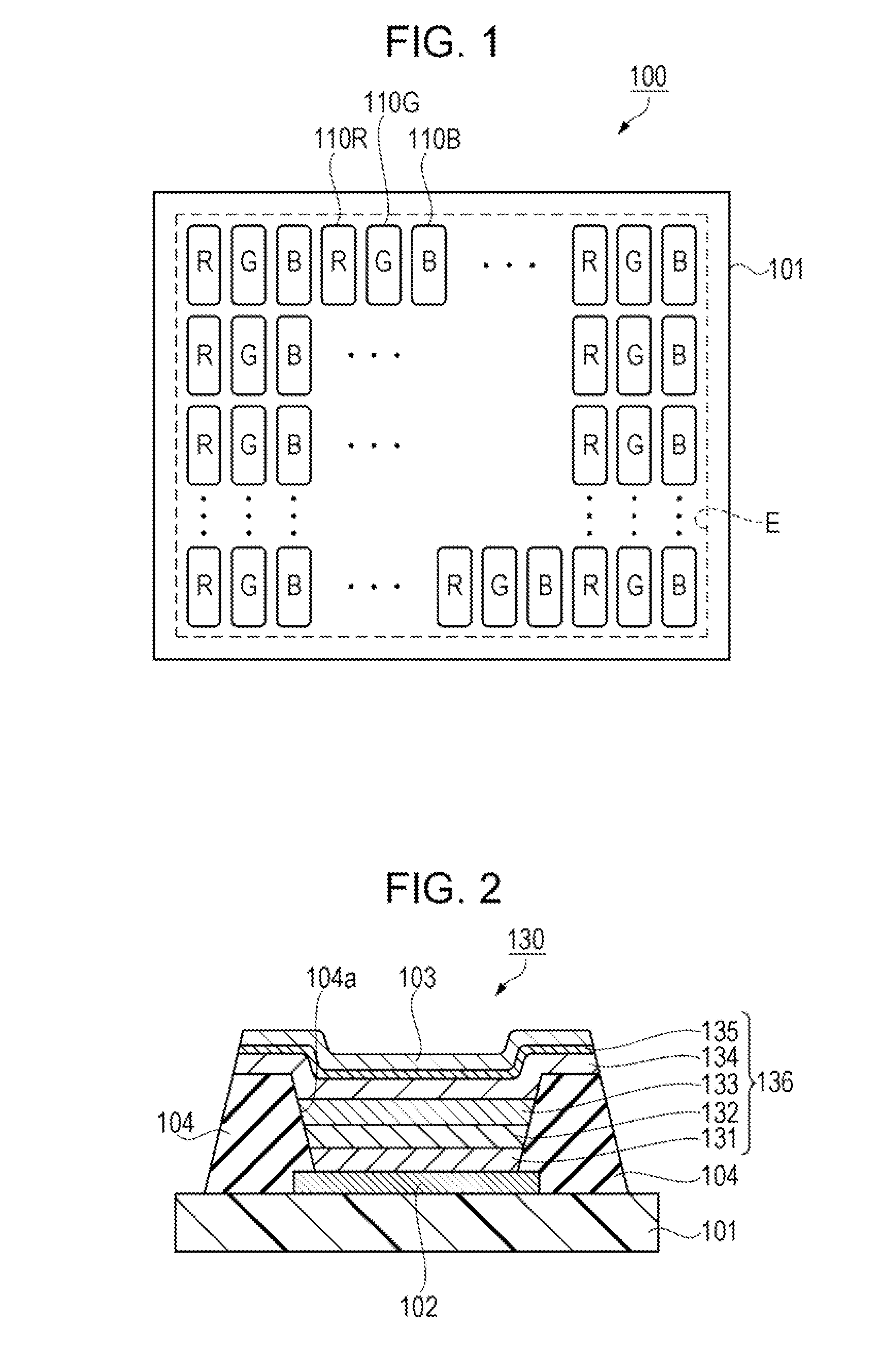Ink for forming functional layer, ink container, discharging apparatus, method for forming functional layer, method for manufacturing organic el element, light emitting device, and electronic apparatus
- Summary
- Abstract
- Description
- Claims
- Application Information
AI Technical Summary
Benefits of technology
Problems solved by technology
Method used
Image
Examples
first embodiment
[0102]First, a light emitting device of a first embodiment will be described with reference to FIG. 1 and FIG. 2. FIG. 1 is a plan view illustrating a configuration of the light emitting device schematically. FIG. 2 is a schematic cross-sectional view illustrating a configuration of an organic EL element.
[0103]As shown in FIG. 1, a light emitting device 100 of the first embodiment includes an element substrate 101 in which sub pixels 110R, 110G and 110B that obtain light emitting (light emitting color) of red (R), green (C), and blue (B) are arranged. Each of the sub pixels 110R, 110G and 110B has an approximate rectangular shape and is arranged in a matrix form in a display area E of the element substrate 101. Hereinafter, a sub pixel 110 is also referred to the generic term of the sub pixels 110R, 110G and 110B. The sub pixel 110 of the same light emitting color is arranged in the vertical direction (column direction or longitudinal direction of the sub pixel ...
example 1-1 to example 1-25
[0193]As shown in FIG. 11, the ink for forming a positive hole injection layer of Example 1-1 to Example 1-25 includes m-MTDATA as a positive hole injection material (third component) of 0.3 wt % in which each of 25 kinds of aromatic solvents as a first component described above is combined to Diethyleneglycol-butylmethyl-ether having the boiling point of 212° C. among seven kinds of aliphatic solvents as a second component described above. The volume fraction of the first component is 70 vol % and the volume fraction of the second component is 30 vol % in the mixed solvent of the first component and the second component. In other words, the volume fraction of the second component in Example 1-1 to Example 1-25 increases by 10 vol % with respect to Comparative Example 1-26 to Comparative Example 1-50.
[0194]In the ink for forming a positive hole injection layer of Example 1-1 to Example 1-25, since the second component of which the surface tension is smaller than the surface tension ...
example 1-26 to example 1-34
[0197]As shown in FIG. 12, the ink for forming a positive hole injection layer of Example 1-26 to Example 1-34 includes m-MTDATA as a positive hole injection material (third component) of 0.3 wt % in which each of nine kinds of the first components in order from the highest boiling point among 25 kinds of aromatic solvents described above is combined to Diethyleneglycol-dibuthyl-ether having the boiling point of 256° C. among seven kinds of aliphatic solvents as a second component described above. The volume fraction of the first component in the mixed solvent of the first component and the second component is 70 vol %, and the volume fraction of the second component is 30 vol %. In other words, the volume fraction of the second component in Example 1-26 to Example 1-34 increases by 10 vol % with respect to Comparative Example 1-67 to Comparative Example 1-75.
[0198]In the ink for forming a positive hole injection layer of Example 1-26 to Example 1-34 in which the difference Δbp betw...
PUM
 Login to View More
Login to View More Abstract
Description
Claims
Application Information
 Login to View More
Login to View More - R&D Engineer
- R&D Manager
- IP Professional
- Industry Leading Data Capabilities
- Powerful AI technology
- Patent DNA Extraction
Browse by: Latest US Patents, China's latest patents, Technical Efficacy Thesaurus, Application Domain, Technology Topic, Popular Technical Reports.
© 2024 PatSnap. All rights reserved.Legal|Privacy policy|Modern Slavery Act Transparency Statement|Sitemap|About US| Contact US: help@patsnap.com










